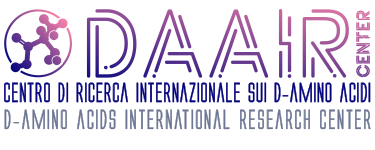D-Amino acids in immune system
An interesting review concerning the role of D-AAs, and their metabolism, in the innate immune system has been recently reported by (Sasabe and Suzuki, 2018).
D-amino acid oxidase (DAAO), the enzyme deputed to D-AAs degradation, is present in granule fraction of human neutrophilic leukocytes (Eckstein et al., 1971): by oxidizing D-AAs, DAAO generates hydrogen peroxide. It has been proposed that hydrogen peroxide, chloride ions and myeloperoxidase form a potent bactericidal system. DAAO has been also proposed to be located on the membrane of neutrophilic leukocytes: following phagocytosis, DAAO produces hydrogen peroxide within phagosomes (Robinson et al., 1978), although this conclusion is still debated. Actually, a model was proposed by (Sasabe and Suzuki, 2018) in which aromatic D-AAs (such as D-Phe and D-Tyr) chemo-attract human neutrophils (probably thorough GPR109B, a G protein-coupled receptor) (Irukayama-Tomobe et al., 2009) and these cells eliminate bacteria through D-AAs oxidation within phagosome. Bacteria can survive to DAAO activity through actively importing D-AAs (e.g., D-Ala is imported by dalS, an ABC importer in S. typhimorium).
DAAO is also present in the luminal epithelium of the small intestine of animals (and humans): notably, its level is induced by feeding carps with D-Ala (Sarower et al., 2003). In Muc2-positive secretory vesicles of goblet cells and of enterocytes (Sasabe et al., 2016) DAAO expression is induced by vancomycin-sensitive intestinal microbes and it is released to modulate the gut microbiota. This effect can be due to hydrogen peroxide generation by DAAO-catalyzed oxidation of bacterial D-AAs, which limits colonization of pathogenic bacteria (such as Vibrio cholerae, a good producer of D-Met) and favours commensal bacteria Lactobacilli (which are resistant to hydrogen peroxide).
D-AAs, such as D-Leu and D-Phe found in respiratory isolates of Staphylococcus species, can inhibit the innate immune response by preventing the release of antimicrobial peptides through sweet taste receptors (i.e. T1R2/3) and in this way can modulate the microbial community of the upper airways (Lee et al., 2017). Notably, D-Trp in mice ameliorates allergic airway inflammation and hyper-responsiveness (Kepert et al., 2017).
References:
Eckstein, M. R., Baehner, R. L., and Nathan, D. G. (1971) Amino acid oxidase of leukocytes in relation to H2O2 -mediated bacterial killing. J. Clin. Invest. 50, 1985–1991.
Irukayama-Tomobe, Y., Tanaka, H., Yokomizo, T., Hashidate-Yoshida, T., Yanagisawa, M., and Sakurai, T. (2009) Aromatic D-amino acids act as chemoattractant factors for human leukocytes through a G protein-coupled receptor, GPR109B. Proc. Natl. Acad. Sci. U.S.A. 106, 3930–3934.
Kepert, I., Fonseca, J., Muller, C., Milger, K., Hochwind, K., Kostric, M., Fedoseeva, M., Ohnmacht, C., Dehmel, S., Nathan, P., Bartel, S., Eickelberg, O., Schloter, M., Hartmann, A., Schmitt-Kopplin, P., and Krauss-Etschmann, S. (2017) D-Tryptophan from probiotic bacteria influences the gut microbiome and allergic airway disease. J. Allergy Clin. Immunol. 139, 1525–1535.
Lee, R. J., Hariri, B. M., McMahon, D. B., Chen, B., Doghramji, L., Adappa, N. D., Palmer, J. N., Kennedy, D. W., Jiang, P., Margolskee, R. F., and Cohen, N. A. (2017) Bacterial D-amino acids suppress sinonasal innate immunity through sweet taste receptors in solitary chemosensory cells. Sci. Signal. 10:eaam7703.
Robinson, J. M., Briggs, R. T., and Karnovsky, M. J. (1978) Localization of D-amino acid oxidase on the cell surface of human polymorphonuclear leukocytes. J. Cell Biol. 77, 59–71.
Sasabe, J., Miyoshi, Y., Rakoff-Nahoum, S., Zhang, T., Mita, M., Davis, B. M., Hamase, K., and Waldor, M. K. (2016) Interplay between microbial D-amino acids and host D-amino acid oxidase modifies murine mucosal defence and gut microbiota. Nat. Microbiol. 1:16125.
Sasabe, J., and Suzuki, M. (2018) Emerging role of D-amino acid metabolism in the innate defense. Front. Microbiol. 9:933.
Sarower, M. G., Okada, S., and Abe, H. (2003) Molecular characterization of D-amino acid oxidase from common carp Cyprinus carpio and its induction with exogenous free D-alanine. Arch. Biochem. Biophys. 420, 121–129.
Authors:
Loredano Pollegioni, Università degli studi dell’Insubria
